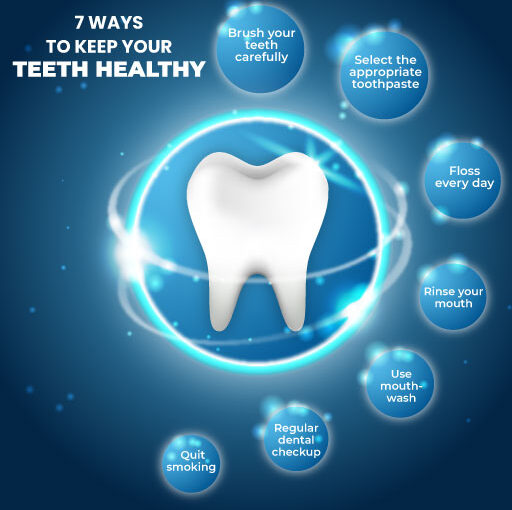7 Ways to keep your Teeth Healthy
The most important action a person can take to prevent and treat gum disease is to maintain good oral hygiene. When it comes to oral health, most people tend to overlook their gums in favor of a bright, white smile. Healthy teeth, on the other hand, necessitate healthy gums.
Tooth loss can occur as a result of gum disease. Fortunately, many steps can be taken to prevent and even reverse gum disease. These are some examples:
- Brushing the teeth correctly
- Deciding on the best toothpaste
- Flossing on a daily basis, using caution when rinsing out the mouth with mouthwash, and having regular dental checkups
- Quitting smoking
This blog post will look at how these steps can help keep your gums healthy. We also offer diet recommendations for healthy gums and explain how to recognize the signs of gum disease.
7 Ways to Maintain Gum Health
Adopting the following habits will assist a person in properly caring for their teeth and gums, thereby preventing gum disease.
- Brush your teeth carefully.
You should brush your teeth thoroughly and floss as well.
- Select the appropriate toothpaste
Most stores’ toothpaste alleys will have a wide range of toothpaste options, from whitening products to baking soda-based formulas.
- Floss every day
Many people ignore daily flossing, but the American Dental Association (ADA) recognizes it as an important part of oral health care.
Flossing is a technique for removing food and plaque from between the teeth and gums. If food and plaque remain in these areas, tartar, a hard buildup of bacteria that only a dentist can remove, can form. Tartar buildup can cause gum disease.
- Thoroughly rinse your mouth.
After brushing their teeth, many people rinse their mouths. Oral hygiene practices, on the other hand, should supplement the effectiveness of fluoride products such as toothpaste.
When a person rinses their mouth with water after brushing their teeth with fluoride toothpaste, the fluoride is washed away.
In contrast, rinsing one’s mouth after eating may remove food and bacteria that can lead to plaque and tartar.
- Make use of mouthwash
According to the American Dental Association, there are two types of mouthwash: therapeutic and cosmetic. Both are available without a prescription.
A therapeutic mouthwash can help in the following ways:
- keep gum disease away
- Reduce the rate at which tartar forms, as well as the amount of plaque on the teeth, by removing food particles from the mouth.
- Get a regular dental checkup for your dental health
Professional cleaning of the mouth is usually included in a dental checkup. Only a professional cleaning can remove tartar from the teeth. Professional cleaning can also assist in removing plaque that a person may have missed while brushing their teeth.
A dentist can help identify the early signs of gum disease and gingivitis, a condition in which the gums become inflamed, with regular visits. Early detection can aid in the prevention of more serious problems.
- Quit smoking
Smoking makes a person more susceptible to gum disease because it weakens the immune system, according to the Centers for Disease Control and Prevention (CDC)Trusted Source.
To help reduce the risk of developing gum disease, the CDC recommends quitting smoking right away. Other tobacco products can also increase a person’s risk.
It is best to stay away from the following foods and beverages:
- Carbonated soft drinks containing phosphoric and citric acids, as well as sugar Alcohol, can cause mouth dryness
- Sticky candies and sweets that linger in the mouth
- Starchy foods that can cause plaque buildup in the teeth
We hope you get all of the important information so try to follow oral hygiene.

